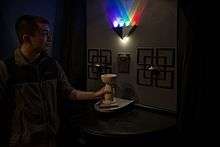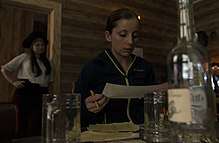Escape room

An escape room, also known as an "escape game", is a physical adventure game in which players solve a series of puzzles and riddles using clues, hints, and strategy to complete the objectives at hand. Players are given a set time limit to unveil the secret plot which is hidden within the rooms. Escape rooms are inspired by "escape-the-room"–style video games. Games are set in a variety of fictional locations, such as prison cells, dungeons, and space stations, and usually the various puzzles and riddles themselves follow the theme of the room.
Escape rooms became popular in North America, Europe and East Asia in the 2010s. Permanent escape rooms in fixed locations were first opened in Asia[1] and followed later in Hungary, North America, Australia, New Zealand, Russia and South America.[2]
History
Different attractions contained elements similar to modern escape rooms and could thus be seen as precursors to the idea, as haunted houses, scavenger hunts, the family entertainment center 5 Wits (opened in 2004) or interactive theater (e.g. Sleep No More, inaugurated in 2003).
Real Escape Game (REG) in Japan was developed by 35-year-old Takao Kato,[3] of the Kyoto publishing company, SCRAP Co., in 2007. It is based in Kyoto, Japan and produces a free magazine by the same name. Beyond Japan, escape games appeared in Singapore from 2011,[4] growing to over 50 games by 2015.[5] Kazuya Iwata, a friend of Kato, brought Real Escape Game to San Francisco in 2012.[6] The following year, Seattle-based Puzzle Break founded by Nate Martin became the first American-based escape room company.[7] Japanese games were primarily composed of logical puzzles, such as mathematical sequences or colour-coding, just like the video games that inspired them.
Parapark, a Hungarian franchise that later operated in 20 locations in Europe and Australia, was founded in 2011 in Budapest.[8] The founder, Attila Gyurkovics, claims he had no information about the Japanese escape games and based the game on Mihály Csíkszentmihályi's flow theory and his job experience as personality trainer.[9] As opposed to the Japanese precursors, in the games of Parapark players mainly had to find hidden keys or reach seemingly unattainable ones in order to advance.
In 2012 a Swiss physics professor created a scientific escape game for his students. The game was later offered to the public under the name of AdventureRooms and distributed as a franchise in twenty countries. The Adventure Rooms introduced scientific puzzles (e.g. hidden infrared or polarized codes) to the genre.[10][11]
As of September 2017, there were over 8,000 escape room venues worldwide.[12] These can be particularly lucrative for the operators, as the upfront investment has been as low as US $7,000, while a party of 4-8 customers pay around US $25–30 per person for one hour[13] to play, potentially generating annual revenue upwards of several hundred thousand dollars.[14]
The format of a room or area containing puzzles or challenges has featured in multiple TV game shows over the years, including Now Get Out of That,[15] The Adventure Game,[16] The Crystal Maze[16] and Fort Boyard. A similar experience can be found in interactive fiction software, and escape the room video games.
Reception

The South China Morning Post described escape rooms as a hit among "[h]ighly stressed students and overworked young professionals."[17] Sometimes the excitement becomes a bit much, though, and players get so invested that they tear down equipment or decorations inside their "fake" prisons, as Zhu Yumeng, chief operating officer of Beijing room escape game site Taoquan, told China Daily.[18]
The use of Hong Kong room "escapes" as distractions from the living conditions of the real city of Hong Kong has been reviewed by local journalists.[19][20]
On December 24, 2016, then-U.S. President Barack Obama and his family visited Breakout Waikiki in Honolulu after being challenged on Twitter by the escape room, and successfully completed the Mission Manoa room with 12 seconds remaining.[21][22][23][24][25]
A 2015 American Science Channel television game show Race to Escape is based on this theme, followed in 2017 by Escape! with Janet Varney.
Stories
Some common themes and storylines that are often found in escape rooms include zombies, haunted houses, science laboratories, prisons, pirates, treasure hunting, hostage, and kidnappings.
Puzzles
Some of the puzzles escape rooms usually include are: hidden objects, team communication, light, counting, noticing something obvious in the room, using something in an unusual way, symbol substitution with a key, searching for objects in images, assembly of a physical object, algebra and other mathematics, pattern identification, riddles, ciphers and others.[26] An example of escape room puzzle would be placing a code on a spinning fan so that it can only be read using a stroboscope in the dark. Therefore, players have to turn off the light, turn on the stroboscope, notice the spinning fan, read the code and apply it further down the game.
Evolution
Escape rooms are evolving at a fast pace. The first games consisted mainly of logical puzzles that were solved with paper and pencil. Later padlocks were introduced that could be opened by finding hidden keys and codes using objects found in the rooms . Finally, automation technology, immersive decoration and more elaborate storylines are being used to enhance the visitor experience, make puzzles more interactive and to create an experience that is more theatrical and atmospheric.
References
- ↑ "The unbelievably lucrative business of escape rooms". MarketWatch. Retrieved 20 July 2015.
- ↑ Raspopina, Sasha (2015-07-23). "Great escapes: the strange rise of live-action quest games in Russia". The Guardian. ISSN 0261-3077. Retrieved 2017-01-16.
- ↑ Corkill, Edan (2009-12-20). "Real Escape Game brings its creator's wonderment to life". Japan Times. Retrieved 2013-03-31.
- ↑ Marinho, Natalie (2012-01-31). "The Real Escape Game in Singapore". recognitionpattern. Archived from the original on 2012-07-24. Retrieved 2013-03-31.
- ↑ "Peeking Behind the Locked Door: A Survey of Escape Room Facilities" (PDF). White Paper. Retrieved 2015-05-24.
- ↑ Cheng, Evelyn (21 June 2014). "Real-life 'escape rooms' are new US gaming trend". CNBC. Retrieved 12 July 2016.
- ↑ Galbraith, Susan. "What in the world is an Escape Room, and how do you survive it??". KOMO. Retrieved 2017-04-19.
- ↑ Bence, Gyulai. "ParaPark: tökéletes élmény egy romkocsma pincéjében". Retrieved 2016-07-17.
- ↑ Kummer, Krisztián (March 2013). "Room escape games the latest craze in Budapest". Budapest Business Journal.
- ↑ Hess, Stéphane (September 10, 2013). "Physik: Kriminelle Energie erwünscht" (PDF). "BILDUNG SCHWEIZ" (Education Switzerland). pp. 24–25. Retrieved April 21, 2018.
- ↑ Tremaine, Fergus (March 21, 2018). "How an enquiry landed me in the centre of a powerhouse brand". Linkedin. Retrieved April 21, 2018.
- ↑ "By the numbers: UK vs the rest of the world | Exit Games UK". exitgames.co.uk. Retrieved 2018-04-21.
- ↑ "For $28, this Alpharetta business will lock you inside a room". myajc. Retrieved 2017-01-16.
- ↑ French, Sally; Shaw, Jessica Marmor (July 20, 2015). "The unbelievably lucrative business of escape rooms". MarketWatch. Retrieved June 19, 2016.
- ↑ "Now Get Out of That". Labyrinth Games. Retrieved 2018-01-04.
- 1 2 "Prigionieri in una scatola?". Io gioco (in Italian) (supplement to The Games Machine n. 346). 2017. p. 20.
- ↑ "Real-life escape games offer respite from daily stresses". South China Morning Post. Retrieved 2016-10-14.
- ↑ "Rooms with a different kind of view|People|chinadaily.com.cn". usa.chinadaily.com.cn. Retrieved 2016-10-14.
- ↑ "Real-life escape games offer respite from daily stresses|". South China Morning Post. 2013-02-13. Retrieved 2013-04-10.
- ↑ "Hong Kong Thrill Seekers think their way to freedom|". CBC News. 2013-02-22. Retrieved 2013-02-22.
- ↑ Press, Associated (December 24, 2016). "The Latest: President Obama Wishes Crowd Merry Christmas". NewYorkTimes. Retrieved December 26, 2016.
- ↑ Reporter, Mike Hayes BuzzFeed News. "The Obamas Successfully Beat A Live Action Escape Game On Vacation". BuzzFeed. Retrieved 2017-04-18.
- ↑ "Obama visit to escape room surprises Breakout KC's Waikiki location | The Kansas City Star". www.kansascity.com. Retrieved 2017-04-18.
- ↑ Staff, AOL. "Obama spent Christmas Eve doing a live-action "escape room" game with his daughters". AOL.com. Retrieved 2017-04-18.
- ↑ "Breakout Waikiki on Twitter". Twitter. Retrieved 2017-04-18.
- ↑ "101 Best Escape Room Puzzle Ideas". Nowescape Blog. 2016-03-18. Retrieved 2018-03-11.
External links
| Wikimedia Commons has media related to Escape rooms. |